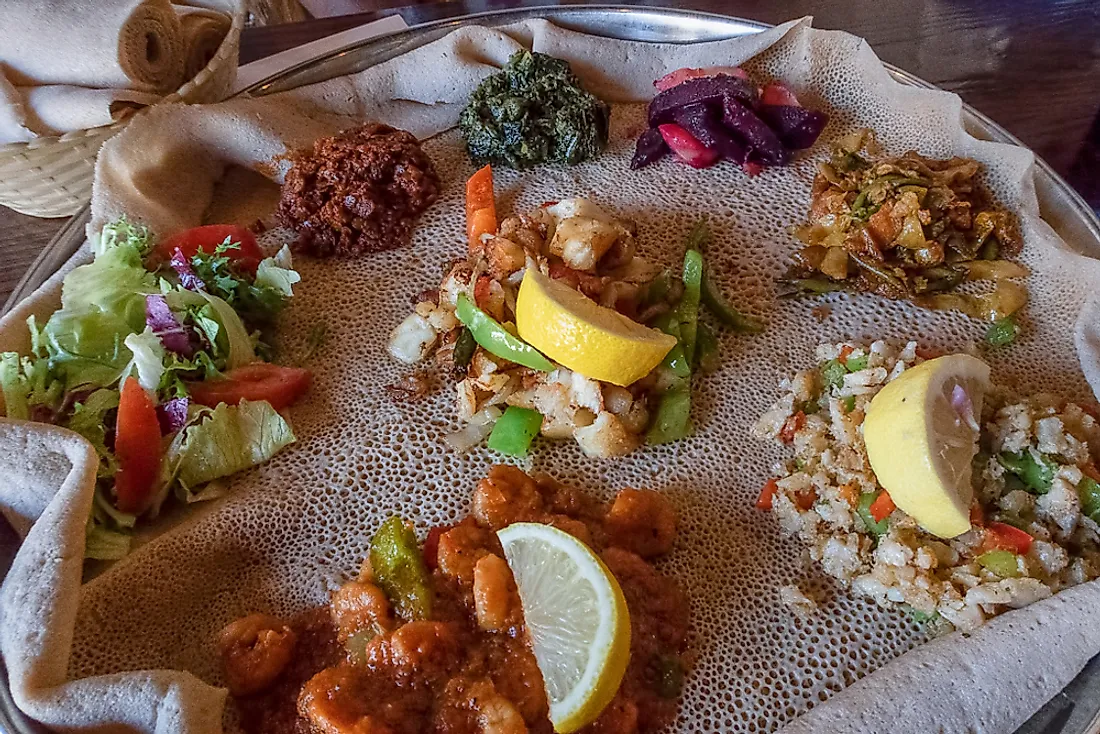The Culture Of Eritrea

Located in the Horn of Africa, Eritrea is a country with a population of around 5.9 million. People belonging to a large number of ethnic groups reside in the country. The Tigrinya is the largest of these groups. Other minority ethnic communities include the Tigre, Sago, Kunama, Rashaida, etc. The country has three official languages: Arabic, English, and Tigrinya. Other popular languages include the Tigre, Afar, Kunama, etc. About 63% of the Eritrean population is affiliated to Christianity. Islam is the religion of around 36% of the population.
Cuisine
The cuisine of Eritrea reflects the cultures of its indigenous people and that of the neighboring countries. A traditional Eritrean meal consists of a spicy stew called tsebhi made with mutton, lamb, or beef. It is served with a sourdough-risen flatbread called taita that is made from wheat, sorghum or teff. A legume paste called hilbet also accompanies the stew and the bread. Seafood is an important part of the diet of the Eritreans. The Fit-fit is a common breakfast dish in the country. It is basically shredded flatbread served with spiced clarified butter and topped with berbere (a spice mixture). A scoop of yogurt is also served with the bread as a dip. Another Eritrean dish that is popular in the lowlands is called the akelet. It is a type of porridge made of water and flour. An indentation is made at its center which is filled with clarified butter and spices while yogurt is poured along the sides. Often, an Eritrean meal is served in one large plate which is shared by several diners. Coffee is a popular beverage in the country.
Coffee
The coffee ceremony is a unique aspect of the Eritrean culture. Often, the end of a long, working day is marked with this ceremony. Strong, aromatic coffee is offered to all family members and neighbors or other guests. Coffee is usually served in thimble-sized cups without handles. Snacks like raisins, popcorn, bread, etc., are also offered in large trays as accompaniment. During such ceremonies, the woman of the household roasts green coffee beans over a charcoal fire. She ensures that the aroma of the coffee wafts under the nose of those participating in the ceremony. Then, the beans are ground into a powder and the coffee is prepared. During the process, frankincense is burnt to fill the air with a pleasant odor.
Eritrean Literature And The Arts
The earliest published works of Eritrean literature focussed on folktales, legends, and traditional poems. Most of the country’s literature between the 4th and the 11th centuries was in the Ge'ez language. Later, literature in the Tigrinya language was produced. It was mostly influenced by the teachings of Christian missionaries from various European countries. The country’s literature and its culture as a whole were repressed during the Italian colonial period in the early 20th century. Under the British rule, however, the country’s culture was once more revived. The first novels in the Tigrinya language were thus published in the second half of the 20th century.
Most common paintings in Eritrea involve the depiction of religious themes and fables in “storyboard’’ forms using a base of canvas, skin, or parchment. Churches in the country are usually painted with bright and dramatic murals. Ceramic work is one of the oldest crafts of Eritrea. Other traditional crafts of the country include weaving and basket-making, jewelry-making, leather-work, wood carving, etc.
Performance Arts In Eritrea
Every ethnic community in the country has its own tradition of music and dance. They are performed to the rhythm of locally-produced instruments like kiras, watas (stringed instruments), tambourines, flutes, etc. Songs and dances are an integral part of Eritrean culture and often mark major life events like births and marriages. In the urban centers of Eritrea, modern contemporary music is also highly popular, especially among the youth.
Life In An Eritrean Society
The traditional Eritrean society is mainly patriarchal in nature. The status of women in many of the country’s communities is regarded as inferior to that of men. However, this situation is slowly changing due to the impact of the government’s policies that are aimed to provide equal rights and freedoms to Eritrean women. While women in urban areas enter the workforce, those in rural areas are mainly assigned the task of managing households and children. However, they do participate in some agricultural activities. The status of Eritrean women also changed for the better following the war of liberation where women fought side by side with men to free the country.
The marriage customs vary among the ethnic groups of the country. Early marriages are common. Marriages are usually arranged by the family, especially in the rural areas. The size of the domestic units varies from nuclear to extended. Men usually are the decision-makers in the household, especially in financial matters. Inheritance rules vary according to the customs of the various ethnic groups. However, usually, the sons receive greater inheritance rights than the daughters.
Children are raised and their behaviors are monitored by the parents as well the extended family members, neighbors and the community at large. The gender roles are taught to the boys and girls from quite an early age. While girls assist their mothers in domestic chores, boys tend to the crop fields and family livestock. Although more and more Eritrean children are now attending school, those belonging to the nomadic and semi-nomadic communities are usually unable to attend school regularly and dropout rates are high in such communities.
Respect for the elders is deep-rooted in the Eritrean society. Public display of affection among members of the opposite sex is frowned upon. Friends or relatives of the same sex, however, mix freely.











